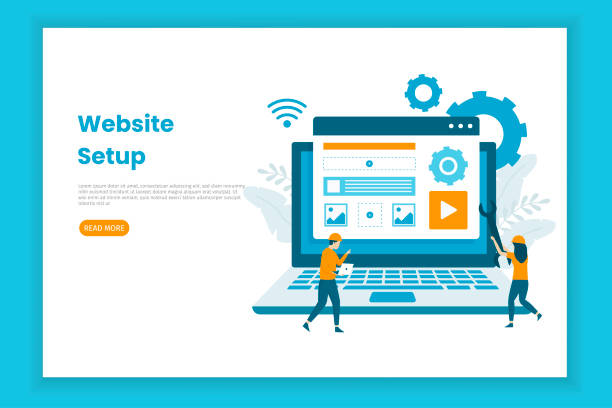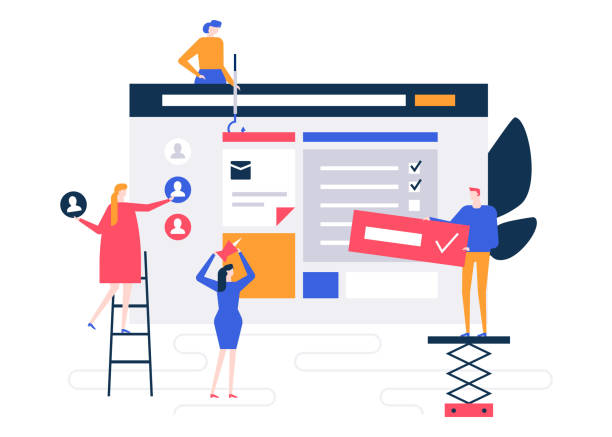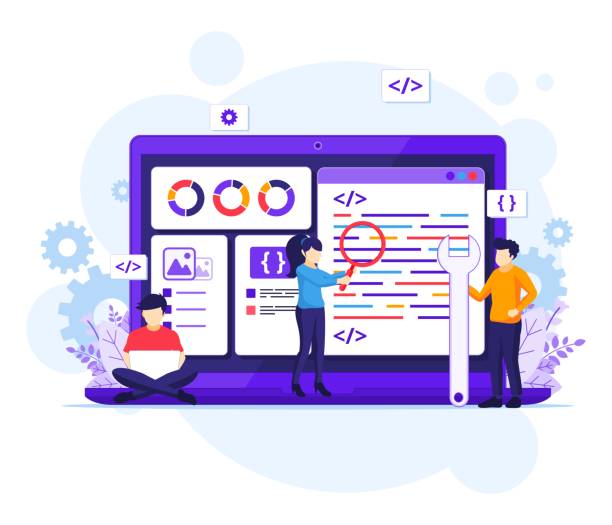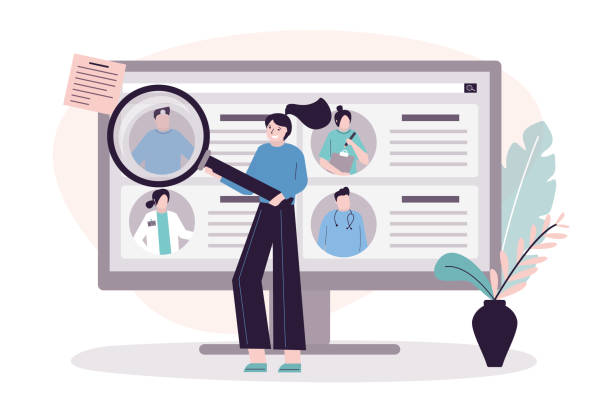New Horizons with Professional Website Design
![]()
In today’s world, where digitalization is expanding every day, having a website is not just an option, but a vital necessity.
However, merely having a website is not enough; what matters is professional website design that can create a powerful and impactful online presence for you or your business.
A #professional website not only acts as your online storefront but also serves as a powerful tool for #marketing, #customer communication, and #sales increase.
This section will explain and educate on the importance of this topic.
Web design is no longer just about coding or graphic layout; rather, it is a comprehensive process that includes a deep understanding of user needs, business goals, and the implementation of effective strategies to achieve these goals.
In fact, an amateur website can severely damage your brand’s credibility, while a website with professional and eye-catching design can build customer trust and encourage more engagement.
This is especially crucial in today’s competitive markets.
Building a professional website involves various stages, from planning and design to development and maintenance.
Each of these stages requires extensive expertise and precision.
For example, in the planning phase, target audiences, site goals, content structure, and the overall site roadmap must be accurately defined.
This stage forms the foundation for all subsequent actions.
Then comes User Interface (UI) and User Experience (UX) design, which directly impacts user satisfaction.
An attractive UI and a smooth, problem-free UX encourage users to spend more time on your site and get closer to your desired goals.
Without a high-quality, professional website, today’s businesses practically lose half of their growth potential.
In the remainder of this article, we will delve into more details of these elements and how to achieve a website design that meets global standards so that you can make the most of your online presence.
Losing potential customers due to an unprofessional website? Rasawweb is your answer! With our specialized corporate website design services:
✅ Enhance your business’s credibility and standing
✅ Experience more targeted customer acquisition
⚡ Act now to get a free consultation!
Key Elements in Building an Advanced Website

To achieve professional website design, knowing and correctly implementing key elements is essential.
These elements go beyond mere visual appeal and include technical, functional, and marketing aspects.
The first and perhaps most important element is a smooth and flawless #user experience (UX).
A website that is difficult to navigate or does not easily provide the information users need quickly loses them.
#Site loading speed is also of high importance; a slow website not only frustrates users but also negatively impacts its SEO ranking.
This section will professionally and guidance-oriented address these points.
Responsive design, which allows the website to display correctly on various devices (mobile, tablet, desktop), is an undeniable necessity today and is considered a cornerstone of modern SEO.
Furthermore, high-quality and relevant content is another main pillar of a professional website.
Content should not only provide useful information but also be engaging and readable.
Using high-quality images and videos also significantly helps increase visual appeal and user interaction.
Website security, especially for sites that collect sensitive user information or conduct financial transactions, is crucial.
SSL certificates and regular security updates are among the measures that must be taken seriously.
#SEO capabilities (search engine optimization) should also be considered from the very early stages of website design and development so that the website can achieve a good ranking in search results.
Finally, website maintainability and scalability are also important; a professional website should be designed in such a way that it can be easily expanded and new features added in the future.
These elements together form a comprehensive and powerful website.
The Role of User Experience (UX) and User Interface (UI) in Professional Website Design

When we talk about professional website design, we cannot overlook the unparalleled importance of #User Experience (UX) and #User Interface (UI).
These two concepts, although often confused, play complementary and vital roles in the success of a website.
UX addresses the overall feeling of the user when interacting with the website; is navigation easy? Is information quickly found? Is the site visually pleasing? In fact, UX is more related to the functional and emotional aspects of user interaction with the website.
This section analytically answers these questions and raises some thought-provoking content to create a deeper understanding of these concepts.
Did you know that poor UX design can even render the best content and products ineffective?
On the other hand, UI refers to the visual and interactive aspects of the website; including buttons, icons, fonts, colors, and the overall layout of elements.
An attractive and user-friendly UI not only makes the website more beautiful but also helps the user interact with elements more easily and perform their tasks.
The optimal combination of these two, literally, makes the difference between an ordinary website and a professional and successful website design.
Great UX makes users return, while great UI encourages them to stay on the site.
Investing in quality UX/UI design not only improves the user experience but also increases conversion rates and strengthens customer loyalty.
To better understand, consider the table below that shows the main differences and impacts of UX and UI in professional website design:
| Feature | User Experience (UX) | User Interface (UI) |
|---|---|---|
| Main Focus | How the user feels when using the product | How the product looks and how the user interacts with it |
| Examples | Ease of navigation, loading speed, user flow logic | Colors, fonts, buttons, images, and animations |
| Goal | To create a pleasant and efficient user experience | To provide a beautiful and intuitive user interface |
| Impact on User | Level of satisfaction, loyalty, and user return | First impression, visual appeal, and initial ease of use |
Understanding the Differences between Frontend and Backend in Web Development

For a #professional website designer, understanding the distinction and interaction between the frontend and backend of a website is crucial.
These two parts, although completely distinct, are entirely interdependent for a website’s correct and integrated functioning.
Frontend refers to everything the end-user directly interacts with and sees in their browser; including visual design, element layout, images, buttons, and any visual interaction.
The main languages used in frontend development include HTML (for content structuring), CSS (for styling and appearance), and JavaScript (for adding interactive functionalities).
This section professionally and explanatorily delves into these concepts.
In contrast, Backend refers to the core and “behind-the-scenes” of a website, responsible for data processing, database management, server logic, and security.
The user never directly sees the backend, but all their requests are processed and answered through the backend.
Common programming languages for backend include PHP, Python (with frameworks like Django or Flask), Ruby (with Ruby on Rails), Node.js, and Java.
Databases such as MySQL, PostgreSQL, and MongoDB are also managed in this section.
A professional website design requires perfect balance and coordination between these two parts.
A beautiful frontend without a powerful backend is meaningless, and vice versa.
Web development teams usually have separate frontend and backend specialists, but in smaller projects, full-stack developers who are proficient in both sections may take responsibility.
Ensuring the proper functioning of both sections is essential for providing a flawless and reliable user experience in website design and development.
Do you know that customers’ first impression of your company is your website? With a powerful corporate website from Rasawweb, multiply your business’s credibility!
✅ Custom and eye-catching design tailored to your brand
✅ Improved user experience and increased customer attraction
⚡ Get a free consultation now!
SEO and Its Place in the Success of a Professional Website

After completing the professional website design, your work is not finished.
In fact, a significant part of your online success depends on #SEO (Search Engine Optimization).
SEO is a set of techniques and strategies aimed at increasing the visibility of your website in organic (non-paid) search engine results like Google.
Without proper SEO, even the best and most beautiful website might get lost among a multitude of other websites and not be found by the target audience.
This section guidance-oriented and analytically clarifies the importance of SEO.
Did you know that 90% of website traffic comes from search engines?
SEO has three main pillars: #On-Page SEO, #Off-Page SEO, and #Technical SEO.
On-Page SEO includes optimizing elements within your website such as keywords, titles, meta descriptions, URL structure, quality content, and images.
Off-Page SEO refers to activities outside your website, such as building quality links from other sites (backlinks), which contribute to your website’s credibility and domain authority.
Technical SEO also deals with technical aspects of the website such as loading speed, responsiveness, XML sitemap, and data structure.
All these aspects help search engines better understand your website and display it to relevant users.
A strong SEO strategy should be considered from the very beginning of the website design process and not as an afterthought.
In this way, your professional website design can achieve its maximum potential in attracting organic traffic and bring favorable results for your business.
Choosing the Right Platform for Your Advanced Website Design

One of the important decisions in the process of professional website design is choosing the right platform or Content Management System (CMS).
This choice not only affects the ease of managing your website but also impacts its development capabilities, security, and maintenance costs.
There are numerous options in the market, each with its advantages and disadvantages.
Common platforms include WordPress, Joomla, Drupal, as well as entirely custom website development.
This section will educate and explain to help you make an informed choice.
Did you know that over 40% of the world’s websites use WordPress?
WordPress is a very popular choice for all types of websites, from personal blogs to large online stores, due to its ease of use, high flexibility, and the availability of thousands of plugins and themes.
For small and medium-sized businesses looking for a quick and cost-effective launch, it’s an excellent choice.
Drupal and Joomla are also powerful CMSs mostly used for large and complex projects with high customization needs and require more technical knowledge.
Finally, custom website development allows you to build a website exactly according to your business’s unique needs, but it usually requires more time and cost.
Important factors to consider when choosing a platform for your professional website design include:
- Your business type and size and the required scalability.
- The available budget for development and maintenance.
- The level of technical expertise of your team to manage the website.
- Security needs and backup capabilities.
- The platform’s SEO capabilities.
Choosing the right platform can provide a solid foundation for your website’s long-term success and is a crucial part of the process of building a professional website.
Security and Maintenance of Professional Website: A Vital Necessity

After completing the professional website design stages and launching it, many people assume the work is done.
But the reality is, this is just the beginning.
#Security and regular #website maintenance are absolutely essential for preserving proper functionality, protecting data, and ensuring continuous user access.
An insecure website can not only harm your brand’s reputation but also lead to the loss of sensitive customer information, legal penalties, and even loss of business.
This section professionally and informatively addresses the importance of this issue.
Did you know that cyber-attacks on websites are increasing every day?
Security measures include installing an SSL certificate (for encrypting communications), using strong passwords, regularly updating the platform and plugins, installing a Web Application Firewall (WAF), and continuously monitoring suspicious activities.
On the other hand, website maintenance includes regular #data backups, checking for broken links, optimizing the database, monitoring loading speed, and ensuring compatibility with various browsers.
These measures not only help maintain security but also lead to improved website performance and user experience.
Without these continuous cares, even the most advanced professional website design will be at risk.
Consider a website like a car; to work well and be safe, it needs regular service and maintenance.
The table below provides a checklist of essential measures for the security and maintenance of a specialized website:
| Category | Action | Description |
|---|---|---|
| Security | Install SSL/TLS | Encrypt data between browser and server |
| Security | Regular Updates | Content management system, plugins, themes |
| Security | Firewall (WAF) | Protection against SQL injection and XSS attacks |
| Maintenance | Regular Backups | Create backup copies of files and databases |
| Maintenance | Check Broken Links | Ensure all links function correctly |
| Maintenance | Database Optimization | Increase website speed and efficiency |
Responsive Design and Mobile-First Approach in Professional Website Design

In the current era, where #smartphones and tablets have become primary tools for internet access, Responsive Design and the #Mobile-First approach are no longer luxuries, but vital requirements in professional website design.
Responsive design means your website is designed to automatically adjust its appearance and functionality to the screen size of the user’s device.
This provides a consistent and optimized user experience across all devices, from large desktops to small smartphones.
This section explanatorily and guidance-oriented addresses these approaches.
The mobile-first approach goes even further than responsive design.
In this method, designers and developers first design the website for mobile devices with small screens and then gradually scale it up for larger displays (such as tablets and desktops).
This approach ensures that the most important content and functionalities are displayed well on the mobile version of the website, as screen space on mobile is more limited.
In addition to improving user experience, #SEO also benefits from responsive design and the mobile-first approach.
Google has announced years ago that it prioritizes mobile-friendly websites in its search results rankings.
Therefore, if you are looking for a strong online presence and want your website to be seen on Google, investing in this type of design for your professional site building is absolutely essential.
Ensuring that your website looks great and functions correctly on any device is a core principle of a professional and future-proof website design.
Tired of your company’s website not getting the visibility it deserves and losing potential customers? Solve this problem forever with professional and effective website design by Rasawweb!
✅ Increase brand credibility and attract customer trust
✅ Attract targeted sales leads
⚡ Contact us now for a free consultation!
Content Strategy for an Attractive Professional Website

Content is king; this phrase is more important than ever in today’s digital world, especially in the field of #professional website design.
A website, no matter how visually appealing or technically flawless, cannot attract and retain audiences without high-quality, relevant, and engaging content.
#Content strategy is the process of planning, creating, publishing, and managing your website’s content.
This content can include text, images, videos, infographics, and even podcasts.
This section entertainingly and thought-provokingly addresses the importance of this topic.
Did you know that high-quality content can increase your website’s organic traffic several times over?
A strong content strategy must begin with a deep understanding of your target audience.
What questions do they have? What problems do they want to solve? What type of information is most attractive to them? Answering these questions helps you create content that directly targets their needs and interests.
Your content should not only be informative but also written in a way that encourages users to interact and guides them towards your website’s #ultimate goal, whether it’s purchasing a product, signing up for a newsletter, or contacting you.
Using relevant keywords is also very important in optimizing content for search engines.
Producing fresh and regular content also signals to search engines that your website is active and up-to-date, which can help improve your SEO ranking.
Ultimately, your professional website design should provide a platform where your valuable content is displayed in the best possible way and creates an unforgettable user experience for visitors.
Great content transforms your website into a reliable source and reference in your field of activity.
Future Trends in the World of Professional Website Design

The world of #professional website design is constantly evolving and progressing, and keeping up with new trends is essential for maintaining competitiveness and providing the best user experience.
#Artificial Intelligence (AI) and Machine Learning (ML) are changing how users design and interact with websites; from advanced chatbots to content personalization based on user behavior.
These technologies enable the creation of much smarter and more responsive websites.
This section informatively and analytically addresses these emerging trends.
Are you ready to design your website for the future?
Another important trend is #Voice User Interface (VUI) and voice search.
With the increasing use of voice assistants like Siri and Alexa, optimizing websites for voice searches has become increasingly important.
#Micro-interactions, which are small details such as visual feedback when clicking a button or liking a post, are increasingly used to improve user experience and visual appeal of websites.
#Dark Mode, which reduces eye strain and saves battery consumption, has also become a popular feature in web design.
Additionally, Single Page Applications (SPAs) and #Headless CMS are also gaining popularity due to their high speed and flexibility.
These trends indicate that professional website design is moving more towards interactivity, personalization, and efficiency.
Considering these developments is crucial for maintaining dynamism and innovation in modern website design.
Frequently Asked Questions
| Question | Answer |
|---|---|
| What does professional website design mean? | Professional website design refers to creating a user-friendly, visually appealing, fast, secure, and search engine-optimized website that meets business goals. |
| What are the most important features of a professional website? | Responsiveness, high speed, security, SEO-friendliness, excellent User Experience (UX) and User Interface (UI), high-quality content, and strong branding. |
| Why is responsive design crucial for a professional website? | Responsive design ensures your website displays correctly on any device (computer, tablet, mobile), which is very important for user experience and Google ranking. |
| What is the role of UI and UX in professional website design? | UX (User Experience) focuses on ease of use and user satisfaction, while UI (User Interface) deals with the visual appearance and user interaction with the website. Both are essential for attracting and retaining audience. |
| What is the place of SEO in professional website design? | SEO is a core pillar. A professional website must have a strong technical structure, optimized content, and high speed to achieve a good ranking in search engine results and be visible. |
| What tools or platforms can be used for professional website design? | Content management platforms like WordPress, Joomla, or Drupal, web development frameworks like React, Angular, or Vue.js, and graphic design tools like Figma or Adobe XD. |
| What are the main stages of designing a professional website? | Planning and research, wireframe and mockup design, development and coding, content entry, testing and review, and finally launch and maintenance. |
| What is the importance of security in a professional website? | Website security is crucial for protecting user information and business credibility. Using SSL/TLS, firewalls, regular backups, and updates are vital measures. |
| Does a professional website require maintenance after launch? | Yes, regular maintenance including software updates, checking broken links, performance monitoring, backups, and adding fresh content is essential for maintaining website efficiency and ranking. |
| What distinguishes a professional website from an amateur one? | A professional website focuses on business goals, provides an exceptional user experience, adheres to high technical standards, and is continuously optimized for improvement, whereas an amateur website usually lacks these features. |
And other services of RasaWeb Advertising Agency in the field of advertising
Smart Custom Software: An effective tool to increase sales by customizing the user experience.
Smart Data Analysis: A novel service to increase customer acquisition through marketing automation.
Smart Website Development: A professional solution for online growth focusing on SEO-driven content strategy.
Smart Advertorials: A specialized service for increasing website visits based on real data.
Smart Google Ads: An effective tool for improving SEO ranking with the help of SEO-driven content strategy.
And over hundreds of other services in the field of internet advertising, advertising consultation, and organizational solutions
Internet Advertising | Advertising Strategy | Advertorial
Resources
Website Design Tips
Comprehensive Website Design Guide
Professional Website Design
Elements of a Successful Website
? At Rasawweb Afarin Digital Marketing Agency, your digital dreams come true with our expertise. From professional SEO optimization to secure website design and creative advertising campaigns, we are your partner in the digital world.
📍 Tehran, Mirdamad Street, next to Bank Markazi, Kazeroun Jonoubi Alley, Ramin Alley, No. 6


